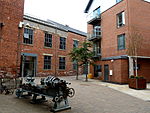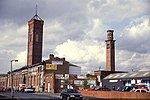Brick Man
Brick Man was an Antony Gormley sculpture proposed in the 1980s for the city of Leeds, West Yorkshire, England. A male human figure standing over 100 feet (30 m) high, it would have stood on a triangle of land bounded by railway lines in the Holbeck area of the city, greeting travellers arriving at Leeds railway station. It would have cost £600,000 and been the largest sculpture in the UK at the time. The sculpture was one of twenty designs produced in response to a competition to find an artwork for the site, but the proposal was ultimately rejected by Leeds City Council in 1988. Conservative councillor Richard Hughes-Rowlands said at the time: "If Mr Gormley is talking about it [Brick Man] going somewhere else, my eyes won't exactly be weeping tears."Gormley has blamed "lack of nerve" for the rejection of his idea, adding: "I think of it still as my best attempt to allude to the collective body." The idea of an iconic landmark sculpture of the human form later saw the light of day in Gormley's Angel of the North.A maquette for the sculpture can be seen in Leeds City Art Gallery.
Excerpt from the Wikipedia article Brick Man (License: CC BY-SA 3.0, Authors).Brick Man
Water Lane, Leeds Holbeck Urban Village
Geographical coordinates (GPS) Address Nearby Places Show on map
Geographical coordinates (GPS)
| Latitude | Longitude |
|---|---|
| N 53.791388888889 ° | E -1.5575 ° |
Address
Water Lane
LS11 5WE Leeds, Holbeck Urban Village
England, United Kingdom
Open on Google Maps









